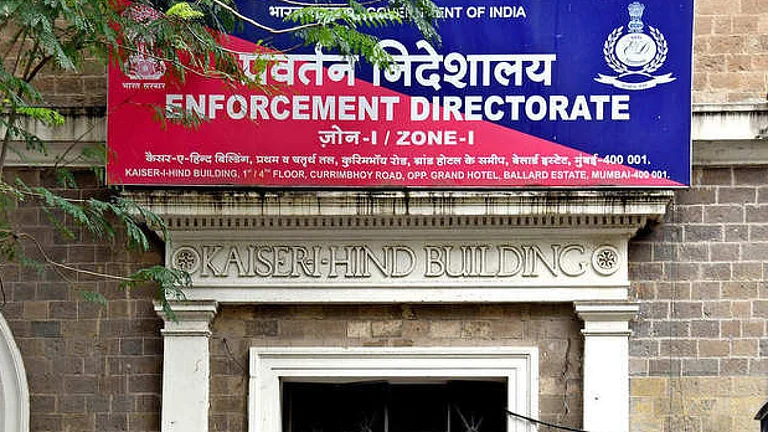As per industry estimates, India registered a sale of almost 38,000 luxury vehicles in 2022 despite growing concerns around inflation. This is quite close to the pre-pandemic figure of 40,000 units sold in 2018. On the other hand, two-wheeler sales are still lagging way behind their pre-pandemic levels, recent figures published by the Federation of Automobile Dealers Associations (FADA) suggest.
When the Indian markets started opening up after the Covid-induced lockdowns, the government announced that it was on the path of recovery, and enthusiastic analysts joined in with inspiring growth forecasts. Figures emerging three years later command a closer look.
The domestic demand in India is exhibiting a K-shaped recovery—where the trajectory of one segment, the formal sector comprising larger businesses, is going diagonally higher and that of the other, representing the informal and low-income groups. Whether it be in consumer goods, housing or automobiles, the dominant trend is that higher-income consumers are able to drive up their consumption, almost touching pre-pandemic levels, whereas consumption has been stagnant, and even falling, for lower income categories—a trend that the vehicle sales numbers are demonstrative of.
While some view this divergence in demand as an urban-rural phenomenon, Shamika Ravi, a member of the Economic Advisory Council to Prime Minister (EAC-PM), says that it might not be the case. “A lot of this debate around urban-rural consumption is actually about the bottom two quintiles versus the top two. We often make the mistake of conflating the bottom two with rural households,” she explains.
There is increasing focus on capital expenditure in the Union budget, but it does not seem to be spurring demand across the lower quintiles, which is necessary for the country’s ambition for a consumption-driven growth story. As per the ICE 360 report by the People’s Research on India’s Consumer Economy, the bottom-most 60% of India’s population experienced a large decline in their household income between 2016 and 2021. For the poorest 20%, the decline in income was as large as 53%.
In 2020, India’s inflation rate remained mostly above 6%, going below that mark for just two months. Under such high inflationary trends, it is the rural and lower-income population which gets impacted more, says Rajani Sinha, chief economist at CareEdge Ratings. “For the upper-income category, whether the inflation is at 6% or 8%, it will not have a very strong impact on their disposable income,” Sinha adds.
Whether one sees it as an urban-rural divide, or as the divergence in consumption between the top and bottom income groups, the fact is that there is a widening fork in the country’s economy, ultimately tied to the employment opportunities going around.
The Growth Perception
When India’s gross domestic product (GDP) declined from 6.3% to 4.4% in the third quarter of FY 2022– 23, several economists and policy heads announced that the country was headed into a period of growth moderation in the upcoming fiscal. They cited the presence of numerous global economic headwinds as the primary cause for this. India’s chief economic advisor, V Anantha Nageswaran, argued that the growth rate for the December quarter seemed depressed because of the data revisions that took place. He suggested that growth rate in the previous years, recalibrated to be higher in its revised estimates, turned out to be a larger base that made current growth appear relatively less. However, quarterly growth figures from the past five years say a different story, it becomes clear that the “base effect” has, in fact, made India’s growth appear larger than it has been at times.

Since the first quarter of FY20, India’s quarterly growth rate went over 5% only five times. Even then, it was the lower base, formed during periods of pandemic-induced degrowth, that propped up the growth rate above 5%. In FY 2019-20, even before the pandemic struck, India’s cumulative growth rate was at just 3.8%. Without discounting for the global factors at play, it is worth exploring at this juncture whether India’s growth story is actually headed for a natural moderation or if the country’s growth deceleration has its roots in more structural causes.
The Pandemic Injury
Not only did the onset of Covid-induced lockdowns trigger a series of movements across India’s consumption and labour markets, it also laid bare some critical issues ailing India’s economy. The poorest and the most vulnerable of the society, largely belonging to the informal sector, were left without jobs or any other source of income. Their sustenance was at stake and the Centre had to step in, expanding the outlay on several subsidy programmes way beyond what was budgeted for FY 2020–21. In the budget that year, the outlay for subsidies and subsidy-related schemes was earmarked at Rs 2.62 lakh crore. However, by the time the actual expenditure was published it had ballooned to Rs 7.58 lakh crore.
The micro, small and medium enterprises (MSME) sector was significantly affected. As the labour market underwent a reverse migration, taking workers from urban spaces back into their rural households, hundreds of thousands of jobs were permanently destroyed, particularly in the MSME sector. A lot of these people ended up seeking refuge in the agricultural sector, which offers lower wages. Some of the shock caused by income loss in this period was absorbed by the increased allocation to Mahatma Gandhi National Rural Employment Guarantee Scheme (MGNREGS), the social security measure that provides up to 100 days of employment to rural households. As against the Rs 71,216.25 crore outlay for MGNREGS in FY 2019-20, the expenditure for the scheme was slightly over Rs 1.1 lakh crore in FY 2020–21.
The additional spending resulted in steep increase in the fiscal deficit. In the first year of the pandemic, India’s fiscal deficit almost doubled to 9.2% of its GDP, an alarmingly large figure. However, the plight of the non-salaried class, which forms the majority in the country, necessitated such social safety measures that year. For the salaried class, weathering the initial shock of the pandemic should have been relatively easier. By dipping into their savings, India’s middle and lower-middle class could keep up with their consumption expenditures at first. But this became progressively difficult as inflation remained hard to tame, resulting in price rise and an effective decline in income.
Providing sustenance at the cost of widening fiscal deficit is not a sustainable strategy. The Centre began to cut down its expenditure on subsidies from the peak it had touched in FY 2020–21. This translated into increased expenses for people who were already suffering from lost incomes, raising the question of employment opportunities.
Employment Gap: The Problem and Solution
The reverse migration caused by the pandemic had increased the dependency on agriculture, signaling a step back in India’s journey of economic transformation. The share of agriculture in overall employment in the country jumped from 42.5% in 2018–19 to 45.5% in 2021–22, according to the latest estimates from the Periodic Labour Force Survey (PLFS).
This is a stress point because it results in declining per worker income within the agriculture sector, says Himanshu, associate professor of economics at Jawaharlal Nehru University (JNU). He suggests that the way out of this income issue should involve employment generation in non-agricultural sectors with a simultaneous increase in income from such employment. According to the data from the latest PLFS, there is presently a decline in real wages, across both urban and rural regular wages, giving justification to Himanshu’s suggestion.
Suman Chowdhury, chief analytical officer at Acuité Ratings & Research, agrees that employment is the key issue to be tackled in order to spur demand in the economy. He says, “The issue is in terms of employment opportunities. This has been an ongoing struggle and the relatively lower returns in the agricultural sector compound the problem. So, people in the rural areas look for additional employment or income opportunities, which is still a work in progress. There is a gap which needs to be addressed and this is not something that can be done overnight.”
Is Higher Capex a Solution?
Over the past two years, the Central government appears to be attempting to address the employment issue, and spur consumption through its increased capital expenditure. In budget 2023–24, it earmarked Rs 10 lakh crore for capex, a 37.4% hike from the Rs 7.28 lakh crore in RE 2022–23, laying emphasis on the fact that the present capex was thrice that of FY20. The finance minister noted that infrastructure and productivity capacity had a large multiplier effect on growth and employment.
“Our biggest job growth is in construction and infrastructure projects. This is why capex is going in the infra sector,” says Ravi. However, some experts note that that the nature and magnitude of the jobs created by the Centre’s push for capex is not sufficient to meet India’s job requirements.
Arun Kumar, retired professor of economics at Jawaharlal Nehru University, says that jobs created in infrastructure projects are “too less and low-paying”. “Modern infrastructure sector [areas] like highways, roadways and railways are all very capital intensive, but they do not generate much employment. In the 1980s, if I saw a road project, there would be hundreds of people working in it. Now, you see 10 people working with big machines instead.” He suggests that employment can instead be generated under MGNREGS and rural development schemes. However, in the Centre’s budget outlay for the present fiscal, both MGNREGS and rural development programmes have taken a cut in expenditure.
MSMEs’ Call for Attention
One problem with the jobs being generated in the infra sector is that it is not yet absorbed the labour that was left stranded by the decline of the MSME sector post-pandemic, feels Sinha. “While all this investment [in capex] is generating jobs, and will continue to generate jobs in the lower income category, it is not that labour is going to move from the unorganised sector, MSMEs and agriculture to these investment projects. Such a movement is not going to happen; at least not immediately,” Rajani Sinha says.

While the government has been taking many measures to improve the situation of the MSME sector, considered to be the backbone of the economy, these moves are falling short, Kumar says. “First, MSME has to be separated into distinct micro, small and medium categories. Right now, almost all the benefits announced for the MSME [sector] go to the medium sector; only a little to the small sector and nothing to the micro sector,” he explains. As per Ministry of Commerce and Industry estimates, there are 6.34 crore MSMEs in India, out of which almost 6.3 crore fall under the micro category. This makes the micro segment account for over 99% of all MSMEs in India, which are almost equally distributed over rural and urban India. These numbers lend some support to the call for having distinct policies for the micro segment.
To solve the issues faced by the micro and small enterprises in technology, finance and marketing, Kumar suggests following the model of China where the micro enterprises are provided leases. “This is how they are able to supply even kites, spindles, dyes and Diwali lights to the Indian market. They are able to supply our cultural symbols to us at a cheaper price than what our industries can do,” he points out. Kumar lauds the steps taken in this year’s budget to set up co-operatives and micro sector units.
Chowdhury agrees with the need for large-scale industrial development. Given the sentiment for the China Plus One strategy, he feels that India can become a global supplier for various products. “This is already happening in some services, but in manufacturing different products, the question is about how we position ourselves as an alternative supplier to China. I think this is something that the government and the industry have to work closely on together to have a solution,” he says.
For this to happen, the private sector will also need to do a course correction and step up its declining capex investments. “The employment situation will partly depend on asset creation by the private sector in a sufficiently large scale,” he adds.
The Missing Private Push
If one looks at the gross fixed capital formation (GFCF) in India, there has been a sharp decline 2007 onwards. In real terms, the ratio of GFCF to GDP in the country at present is similar to the levels achieved more than two decades ago in 2002. A significant factor in the decline of GFCF is the decreasing contribution from the private sector. In 2011, the contribution from the private sector amounted to 31% but it fell to 22% in the following nine years. Although there was a trend reversal in 2017–18, the shift could not sustain itself and fell further down quickly. Ravi notes that this is one structural issue that needs to be addressed seriously. “Despite the uptick in last two quarters, we have been in a decline for over 10 years now. This has become a structural feature and reversing that means a lot has to go into it,” she says.
The government has been spending more on capex projects and has been continuously urging India Inc. to step in as well. Prime Minister Narendra Modi himself appealed to the private sector to match the government’s spending. At a post-budget webinar this year, he said, “I would also call upon the private sector of the country to increase their investment just like the government so that the country gets maximum benefit from it.”
“Unlike the usual case of crowding out, in India it has been a crowding in process. The government capex has almost always had to pull in private investments and not the other way around,” says Ravi. On the other hand, the industry cites the present state of high interest rates as an impediment to increase its investments. Pointing to the multiple opportunities for investment across manufacturing and service sectors, Sanjiv Bajaj, president of industry body Confederation of Indian Industry, said in a recent interview, “In such a situation, we have to be nimble enough where we believe that it is timely to pause the interest hike cycle and to move to at least a neutral stance. This, we think, then will help to create new growth, demand in the country and expand private sector investment cycle to many more sectors.”
However, the private capex’s wait for lower interest rates does not make sense if one looks at the state of India’s principal lending rates over the past few years. “Private capex did not happen even when interest rates were low, and money was available at a cheaper rate. [The industry] was already kind of cash rich, and it did not have much debt, but I do not think they were willing to invest much in capex during 2021 or 2022,” Chowdhury argues. The reference is to the period between May 2020 and May 2022 when India’s repo rate was at just 4%, a surprising 58-year-low.
On top of that, the Modi government had issued a corporate tax cut in 2019, bringing down corporates’ tax liability from 30% to 22%. This was widely contested as a measure that shifted the country’s tax burden from the corporates to the common man, but it provided an opportunity for India’s private sector to clean up its balance sheet. And cleaning up, it did.
When India’s lower- and middle-income classes were reeling under the pressure of the pandemic, India Inc. saved large amounts because of tax cuts and was busy deleveraging its financials. By the end of this fiscal, the combined net debt of Indian companies is projected to be Rs 8 lakh crore, after having touched a high of Rs 12.26 lakh crore at the end of the first year of pandemic.
The current state of capacity utilisation in the manufacturing sector, and the deleveraged state of India Inc.’s balance sheet, provides a great opportunity to push for increased capex from the private sector. Sinha says, “We have been saying that, actually, the ground is all set for private capex to pick up and but, on ground, we are not seeing very strong signs of pickup.”
Now, with global economic uncertainties and an ongoing interest rate hike cycle, it remains to be seen whether private sector will indeed step up its investments. What is certain is that India’s lower- and middle-income classes are not going to have it easy. For those dependent on agricultural revenue, headwinds are already in place, in the form of heatwaves, fears of weak monsoon and export bans. The daily wage earners are struggling to find higher-income opportunities that will help them remain buoyant in the face of inflation. Even for the salaried class, rising rates on recurring payments like home loans are exerting pressure on their savings. In the first half of FY23, total household savings declined to 15.7% of the GDP, as against roughly 20% of the GDP in the previous five years, according to a report by Motilal Oswal Securities.
As India pushes forward with its focus on increased capital expenditure, the burden of which is on the government’s shoulders, it remains unclear whether this is actually helping spur consumption in the economy at all.






























